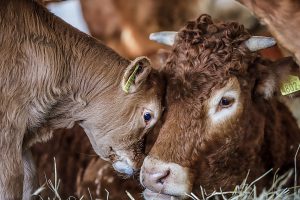In 1957, a chick at slaughter weighed just under a kilo, 900 grams. She was then 56 days old. Thirty years later, this weight is already double at 56 days. And thirty years later, its weight has doubled again. In 60 years, the weight of a 56-day-old chick quadrupled from one to four kilos. Breeding techniques increased the growth capacity, reduced the percentage of body fat and intensified their food intake. As a result, the animals grew faster and faster and could also be slaughtered earlier. Now, broilers in conventional broiler farming are slaughtered as early as 42 days. They then weigh five (!) times as much as a laying hen of the same age. When you see these animals side by side, it is almost unbelievable that they are the same species. However, the breeding process has focused on production, meat or eggs and has left the natural behaviour of the animals untouched. The needs of the chick are unchanged from 100 years ago. This has major implications for the welfare of both the broiler and the laying hen.
A broiler is hungry all day, he or she is bred to eat a lot and grow fast. When food is not available, it pecks at an empty feeder, drinks excessive amounts of water or displays aggressive behaviour towards its peers. We all know that feeling hungry does not bring out the best in us. The unnatural growth of chicks does not take place evenly. Breeding has focused exclusively on the financially interesting part of the chick. Therefore, the breast muscles grow much faster than its legs can carry it. A survey of 51,000 chicks found that only 2.2% of chicks had no problems walking, meaning that almost all chicks in regular farming are lame to a greater or lesser extent and experience pain in doing so. This is 38 million animals in pain, caused by the way they are reared. This completely ignores the importance of the animal. These animals’ pain cannot be eliminated by better housing or an outdoor run. And from this pain, they are not legally protected in any way.



